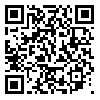BibTeX | RIS | EndNote | Medlars | ProCite | Reference Manager | RefWorks
Send citation to:
URL: http://jdm.tums.ac.ir/article-1-314-en.html
Background and Aim: Although the need for "adequate" amount of keratinized tissue (KT) for periodontal health is questionable, the mucogingival junction (MGJ) often serves as a measurement landmark in periodontal evaluations. Limited information is available on the reproducibility of KT width (KTW) assessment. The purpose of this study was to assess reproducibility of 3 different methods to identify MGJ location.
Materials and Methods: In this test evaluation study, fourteen patients contributed with 40 teeth. At the midbuccal aspect of each tooth, KTW was assessed by 2 independent examiners after MGJ identification by the visual (VM), functional (FM), and visual with histochemical staining (HM) method. Data analysis was based on intra-class correlation coefficients (ICC) and paired t test.
Results: The results of this study exhibits no significant differences in keratinized tissue width assessment in visual and histochemical methods , but a significant difference in functional method is found. Intra- and inter-examiner reproducibility has been shown to be substantially consistent when different methods of mucogingival junction determination are used to measure in order to determining corono apical dimension of the gingival.
Conclusion: Finally the results of this study indicate that all three methods for detecting MGJ location are accurate and reproducible, but if we need more accuracy and reproducibility, the histochemical method is recommended.
| Rights and Permissions | |
 |
This work is licensed under a Creative Commons Attribution-NonCommercial 4.0 International License. |




